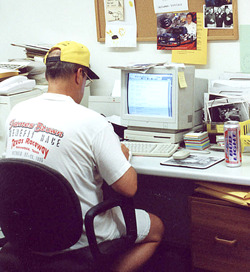|

 |
| Photo
by Jeff Burk |
|
1/8/04
THE BIGGER THEY ARE,
THE HARDER THEY FALL
(from the sky)
 did not particularly want to do this. In a half
sentence, "tell you about airplane-engined dragsters."
However, at the numbing insistence of my editor,
a diehard plane-o-phile, I decided to put out
an extra effort and go through with it.
did not particularly want to do this. In a half
sentence, "tell you about airplane-engined dragsters."
However, at the numbing insistence of my editor,
a diehard plane-o-phile, I decided to put out
an extra effort and go through with it.
Now, why would he want something so arcane published in the non-existent
pages of "Dragracingonline.com?" A.) He's a plane freak, and B.) From what
I'm told, there was a recreation of what the Wright Bros. did 100 years ago at
Kitty Hawk, N.C., this past December. He added 2+2, came up with "6" (that
grade determined by me and what I know about planes) and said, "C. Bley, give me a history on airplane-engined race cars."
How about a history of quantum mechanics? How many times did Betsy Ross
pull a needle through the first American flag? Contrast the views of Steven
Hawking and Werner Heisenberg on how the universe was created.
Okay, okay...here's what I can tell you.
When you're talking airplane-powered cars,
you're talking about one of the two greatest
genius FAMILIES (note the word "Families" and
the, for obvious reasons, overlooking of the
Chrismans) in drag racing history. The Arfonses
of Akron, Ohio, particularly brothers Art and
to a slightly lesser degree, Walt, and their
"Green Monster" series of race cars.
Sometime around late 1953, the two street-racing/sometimes
drag racing half-brothers thought to themselves
that there might be a better way to develop
horsepower than the traditional Ford/Mercury
flathead-motored race cars of the period. Why
not go with an airplane engine? After checking
out a number of choices, they arrived at the
1,700-horsepower Allison airplane engine that
powered the WWII P-51 Mustang and had been used
by hydroplane Gold Cup racers since the late
1940's. Rated at nearly 1,500-horsepower, the
plane motors tripled the output of a nitro-powered
flathead. Hell, theoretically that would crush
the flathead fuel racers, and for a while they
did.
The Arfonses came up with the name "Green Monster" for their race cars,
and it that was an apt description. The brothers' cars were among the very
first of rear-engined race machines, and baby, were they ugly. How ugly? Well, to quote Bo Diddley on how ugly one of his pal's girlfriends was, "The tears rolled down the back of her head to keep from coming towards her face."
These cars were backyard/home-built with the Allison in back of the driver, homely green paint, auto tires in front, and tread then later, thin slick tires in the back. The whole thing looked like you'd stuffed an accordion into
a backpack. What made the "Monsters" worse was that they weighed well over
3,000 pounds, almost double the weight of their conventional weight dragster
competitors. Not only that, but in one of their cars, the "Baloney Slicer," (as opposed to the "Green Monster" moniker) they actually left the propeller
on the back of the engine when they ran. However weird those cars may have
looked they did perform for a while.
For example, while Lloyd Scott ran drag racing's first 150-mph run at the 1955
World Series of Drag Racing, the Arfonses ran
one of two 150s at the inaugural NHRA Nationals
in Great Bend, Kansas. Scott got his first (I
think) in the twin-engined "Bustle Bomb," but
Art Arfons got the next one at 150-mph flat.

|